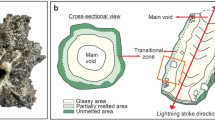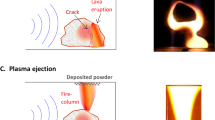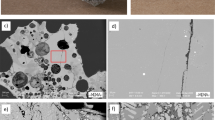Abstract
Observations of ball lightning have been reported for centuries, but the origin of this phenomenon remains an enigma. The ‘average’ ball lightning appears as a sphere with a diameter of 300 mm, a lifetime of about 10 s, and a luminosity similar to a 100-W lamp1. It floats freely in the air, and ends either in an explosion, or by simply fading from view. It almost invariably occurs during stormy weather2,3. Several energy sources have been proposed2,3,4 to explain the light, but none of these models has succeeded in explaining all of the observed characteristics. Here we report a model that potentially accounts for all of those properties, and which has some experimental support. When normal lightning strikes soil, chemical energy is stored in nanoparticles of Si, SiO or SiC, which are ejected into the air as a filamentary network. As the particles are slowly oxidized in air, the stored energy is released as heat and light. We investigated this basic process by exposing soil samples to a lightning-like discharge, which produced chain aggregates of nanoparticles: these particles oxidize at a rate appropriate for explaining the lifetime of ball lightning.
This is a preview of subscription content, access via your institution
Access options
Subscribe to this journal
Receive 51 print issues and online access
$199.00 per year
only $3.90 per issue
Buy this article
- Purchase on Springer Link
- Instant access to full article PDF
Prices may be subject to local taxes which are calculated during checkout


Similar content being viewed by others
References
Smirnov, B. M. The properties and the nature of ball lightning. Phys. Rep. 152, 177–226 (1987).
Barry, J. D. Ball Lightning and Bead Lightning (Plenum, New York, 1980).
Turner, D. J. The structure and stability of ball lightning. Phil. Trans. R. Soc. Lond. A 347, 83–111 (1994).
Singer, S. The Nature of Ball Lightning (Plenum, New York, 1971 ).
Hutchison, S. G., Richardson, L. S. & Wai, C. M. Carbothermic reduction of silicon dioxide—a thermodynamic investigation. Metall. Trans. B 19, 249–253 (1988).
Essene, E. J. & Fisher, D. C. Lightning strike fusion: extreme reduction and metal-silicate liquid immiscibility. Science 234, 189–193 (1986).
Siegel, R. W. in Physics of New Materials 2nd edn (ed. Fujita, F. E.) 66 –106 (Springer, Heidelberg, 1998).
Ludwig, M. H. in Handbook of Optical Properties Vol. II, Optics of Small Particles, Interfaces and Surfaces (eds Hummel, R. E. & Wissmann, P.) 103– 127 (CRC, Boca Raton, 1997).
Friedlander, S. I., Jang, H. D. & Ryu, K. H. Elastic behaviour of nanoparticle chain aggregates. Appl. Phys. Lett. 72, 173–175 (1998).
Fortov, V. E. et al. Highly nonideal classical thermal plasmas: experimental study of ordered macroparticle structures. JETP 84, 256–261 (1997).
Aleksandrov, V. Ya., Borodin, I. P., Kechenko, E. V. & Podmoshenskii, I. V. Rapid coagulation of submicron aerosols into filamentary three-dimensional structures. Sov. Phys. Tech. Phys. 27, 527 –529 (1982).
Cawood, W. & Patterson, H. S. A curious phenomenon shown by highly charged aerosols. Nature 128, 150 (1931).
Aleksandrov, V. Ya., Golubev, E. M. & Podmosheskii, I. V. Aerosol mode of ball lightning. Sov. Phys. Tech. Phys. 27, 1221–1224 (1983).
Lowke, J. J., Uman, M. A. & Liebermann, R. W. Toward a theory of ball lightning. J. Geophys. Res. 74, 6887–6898 (1969).
Deal, B. E. & Grove, A. S. General relationship for the thermal oxidation of silicon. J. Appl. Phys. 36, 3770–3778 (1963).
Massoud, H. Z. & Plummer, J. D. Analytical relationship for the oxidation of silicon in dry oxygen in the thin-film regime. J. Appl. Phys. 62, 3416–3423 (1987).
Jacobson, N. S. Corrosion of silicon-based ceramics in combustion environments. J. Am. Ceram. Soc. 76, 3–28 (1993).
Rayle, W. D. Ball Lightning Characteristics (Note TND-3188, NASA, Washington, 1966).
Andrianov, A. M. & Sinitsyn, V. I. Erosion-discharge model for ball lightning. Sov. Phys. Tech. Phys. 22 , 1342–1347 (1977).
Pemberton, S. T. & Davidson, J. F. Turbulence in the freeboard of a gas-fluidised bed. The significance of ghost bubbles. Chem. Eng. Sci. 39, 829– 840 (1984).
Nagamori, M., Boivin, J. A. & Claveau, A. Gibbs free energies of formation of amorphous Si 2O3, SiO and SiO2. J. Non-Cryst. Solids 189, 270–276 ( 1995).
Littau, K. A. et al. A luminescent silicon nanocrystal colloid via a high-temperature aerosol reaction. J. Phys. Chem. 97, 1224 –1230 (1993).
Bohren, C. F. & Huffman, D. R. Absorption and Scattering of Light by Small Particles (Wiley, New York, 1983).
Palik, E. D. Handbook of Optical Constants of Solids (Academic, Orlando, 1985).
INSPEC Properties of Silicon 75, 938 (Institution of Electrical Engineers, London, 1988).
Acknowledgements
We thank the Electrical and Electronic Engineering Department at the University of Canterbury, especially J. Woudberg, for the use of their high-voltage laboratory; C. Maslin, B. Lane, P. Niamskul and T. Benson for experimental work, supporting that of J. Dinniss, and D. Brown, N. Foot and R. Boyce for technical help. We also thank N. Andrews and J. McKenzie of the Plant and Microbial Sciences Department for electron microscopy.
Author information
Authors and Affiliations
Corresponding author
Rights and permissions
About this article
Cite this article
Abrahamson, J., Dinniss, J. Ball lightning caused by oxidation of nanoparticle networks from normal lightning strikes on soil. Nature 403, 519–521 (2000). https://doi.org/10.1038/35000525
Received:
Accepted:
Issue Date:
DOI: https://doi.org/10.1038/35000525
This article is cited by
-
Localized microwave-heating (LMH) of basalt – Lava, dusty-plasma, and ball-lightning ejection by a “miniature volcano”
Scientific Reports (2019)
-
Lightning-fast chemistry
Nature Chemistry (2019)
-
Negative and positive dust grain effect on the modulation instability of an intense laser propagating in a hot magnetoplasma
Journal of Theoretical and Applied Physics (2017)
-
Nanocarbon synthesis by high-temperature oxidation of nanoparticles
Scientific Reports (2016)
-
Self-organization of frozen light in near-zero-index media with cubic nonlinearity
Scientific Reports (2016)
Comments
By submitting a comment you agree to abide by our Terms and Community Guidelines. If you find something abusive or that does not comply with our terms or guidelines please flag it as inappropriate.



